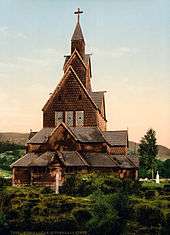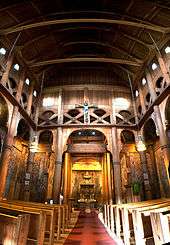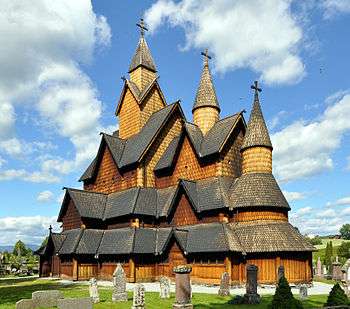Heddal stave church
| Heddal stave church | |
|---|---|
|
Heddal Stave Church, Norway's largest stave church | |
| Type | Church |
| Status | Protected by resolution |
| County | Telemark |
| Municipality | Notodden |
| Year built | Early 13th century |
| ID | 84513 |
| Heddal Church | |
|---|---|
| Location | Notodden, Telemark |
| Country | Norway |
| Denomination | Church of Norway |
| Churchmanship | Evangelical Lutheran |
| Architecture | |
| Status | Parish church |
| Functional status | Active |
| Completed | Early 13th century |
| Specifications | |
| Materials | Wood |
| Administration | |
| Parish | Heddal |
| Diocese | Diocese of Agder |
Heddal stave church (Bokmål Heddal stavkirke, Nynorsk Heddal stavkyrkje) is a stave church located at Heddal in Notodden municipality, Norway.
The church is a triple nave stave church and is Norway's largest stave church. It was constructed at the beginning of the 13th century. After the reformation, the church was in a very poor condition, and a restoration took place during 1849–1851. However, because the restorers lacked the necessary knowledge and skills, yet another restoration was necessary in the 1950s. The interior is marked by the period after the Lutheran Reformation in 1536–1537 and is for a great part a result of the restoration that took place in the 1950s.
Legend

There is a legend telling about the erection of the church and how it was built in three days.
Five farmers (Raud Rygi, Stebbe Straand, Kjeik Sem, Grut Grene and Vrang Stivi) from Heddal had made plans for a church, and they decided to have it built. This is how it happened:

One day, Raud Rygi (one of the five men) met a stranger who was willing to build the church. However, the stranger, set three conditions for doing the job, one of which must be fulfilled before the church was finished:
Raud had three options: fetch the sun and the moon from the sky, forfeit his life-blood, or guess the name of the stranger. Raud thought the last would not prove too difficult, so he agreed to the terms
But time began to run out. All of the building materials had arrived during the first night, and remarkably, the spire was built during the second. It became clear to Raud that the church would be finished on the third day.
Down at heart and fearing for his life, Raud took a walk around in the fields trying to figure out what the stranger's name could be. Still wandering about he had unconsciously arrived at Svintruberget (a rocky hill southeast of the church site) when he suddenly heard a strange but most beautiful and clearly audible female song:
- Hush-hush little Child,
- Tomorrow Finn will bring you the Moon and the Sky.
- He will bring you the Sun and a Christian Heart,
- so pretty Toys for my little Child to play a Part.
Or in Norwegian
- I morgen kommer Finn og bringer oss maanen
- der han kommer forgaar sol og kristenblod
- lokker barna til sang og spel
- men nå mine små, sov stille og vel
Now Raud knew what to do, as the stranger was a mountain troll. As expected, the stranger visited Raud the next day, to present the church. Together they walk over to the church, and Raud walks up to one of the pillars, hugs it as if to straighten it, and says, "Hey Finn, this pillar isn't straight!" Finn snaps back, “I could be even more bent!” and then hastily leaves the church. Raud had solved the riddle after all. The stranger's name was Finn and he lived in the Svintru Mountain. Finn, also known as Finn Fairhair or Finn Fagerlokk, a troll, could not ever after stand the sound of church bells, so he moved along with his family to Himing (Lifjell).
According to legend, the same troll was also responsible for building Nidaros Cathedral, Church of Avaldsnes and Lund Cathedral.
External links
| Wikimedia Commons has media related to Heddal stavkirke. |
- About Norwegian stave churches (in English)
- Attraction information (in English)
Coordinates: 59°34′46″N 9°10′35″E / 59.57944°N 9.17639°E
